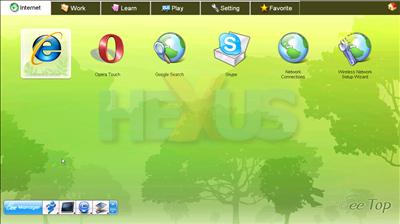Touch-screen goodness gone wayward?
The inclusion of a 15.6in resistive-touchscreen display might be seen as an attempt to lure customers. To ASUS' credit, it's a very good attempt that regrettably stumbles over just a few hurdles.
The display itself - albeit a little cramped in size - is very responsive to both a finger or the bundled stylus. Unfortunately, and in-keeping with the basic specification, the touchscreen doesn't support multi-touch and popular gestures found on devices such as Apple's iPhone and HP's TouchSmart PCs are therefore absent. Further highlighting the system's low-cost credentials, we found the display's viewing angles to be particularly poor.
Nonetheless, as far as single-touch implementation is concerned, ASUS's hardware does the trick - it's suitably responsive and reasonably accurate once fully configured. The problem, we feel, lies within the accompanying software. Using Windows XP Home edition - as opposed to say Windows XP Tablet Edition or Windows Vista - we found the system struggles to make the best of its touchscreen functionality.
Hoping to make amends for Windows XP's lack of touch-friendly applications is ASUS' Eee Home - a finger-friendly software utility that lays on top of Windows XP and does its best to hide Microsoft's ageing operating system. Similar, in a sense, to the numerous touch-friendly overlays placed on touchscreen mobile phones in an effort to hide the vulgar Windows Mobile beneath.
Sadly, despite ASUS' efforts, Eee Home is simply a quick-fix that fails to make use of what touch control has to offer. By simply providing large finger-friendly icons in a manner similar to the Xandros Linux operating system found on its Eee PCs, ASUS' Eee Home is little more than a touch-friendly introduction to an unfriendly subsystem.
As illustrated above, Eee Home offers quick one-touch access to common functions via a selection of tabs; Internet, Work, Learn, Play, Setting and Favourite. Choose an application such as Internet Explorer, however, and you're promptly whisked-away from a touch-friendly interface to a browser that demands a keyboard and mouse.
Motorola's SoftStylus software is pre-installed to offer on-screen keyboard and handwriting recognition functionality, and though the on-screen keyboard works reasonably well, we found the handwriting recognition to be an exercise in futility. Recognising only one character at a time, the use of handwriting is an arduous task and we continued to resort to the good ol' keyboard and mouse.
Despite our inability to thoroughly enjoy the touch aspect, we do believe that touch functionality has its place. The problem, we feel, is that the availability of touch-friendly software is severely limited and is unlikely to become readily available until the arrival of Windows 7's multi-touch APIs later this year.
Today, the Eee Top's touchscreen is little more than a gimmick and can't live without the tried-and-trusted keyboard and mouse.










